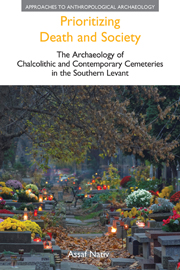 Prioritizing Death and Society
Prioritizing Death and Society from Part III - Contemporary cemeteries
The previous chapters offer an overview of a selection of features and aspects that constitute contemporary cemeteries in Israel and that ultimately coalesce into two fairly distinct strands of analysis and interpretation: one pertaining to the tombstone (see Chapters 11 to 13) and the other to spatial patterning of graves (see Chapter 14). Both are marked by striking differences in content and terminology. While the tombstones were shown to embody and participate in social discourses on levels ranging from the single agent to broad societal structures, the spatial patterning inside the cemeteries revealed negotiations between institutional policy and personal demands. Yet, despite these apparent discrepancies, the tombstone and the spatial arrangement are closely linked. Most importantly, the cemetery constitutes an embodiment of a social community, and its organizing principles have considerable impact both upon its overall concept and its internal structure. Thus, for example, the representation of the community as a loose cluster of single autonomous agents is a direct result of the insistence on single burials.
Single burials and the arrangement of the graves in neat rows are the only characteristics common to all cemeteries analysed. Indeed, the data seems to emphasize that each cemetery otherwise followed its own independent course. Nevertheless, if we were to try to group the cemeteries into categories, it would be misleading to consider all aspects analysed as equally relevant. As observed throughout the foregoing chapters, diferent aspects are associated with diferent social and institutional levels.
To save this book to your Kindle, first ensure [email protected] is added to your Approved Personal Document E-mail List under your Personal Document Settings on the Manage Your Content and Devices page of your Amazon account. Then enter the ‘name’ part of your Kindle email address below. Find out more about saving to your Kindle.
Note you can select to save to either the @free.kindle.com or @kindle.com variations. ‘@free.kindle.com’ emails are free but can only be saved to your device when it is connected to wi-fi. ‘@kindle.com’ emails can be delivered even when you are not connected to wi-fi, but note that service fees apply.
Find out more about the Kindle Personal Document Service.
To save content items to your account, please confirm that you agree to abide by our usage policies. If this is the first time you use this feature, you will be asked to authorise Cambridge Core to connect with your account. Find out more about saving content to Dropbox.
To save content items to your account, please confirm that you agree to abide by our usage policies. If this is the first time you use this feature, you will be asked to authorise Cambridge Core to connect with your account. Find out more about saving content to Google Drive.